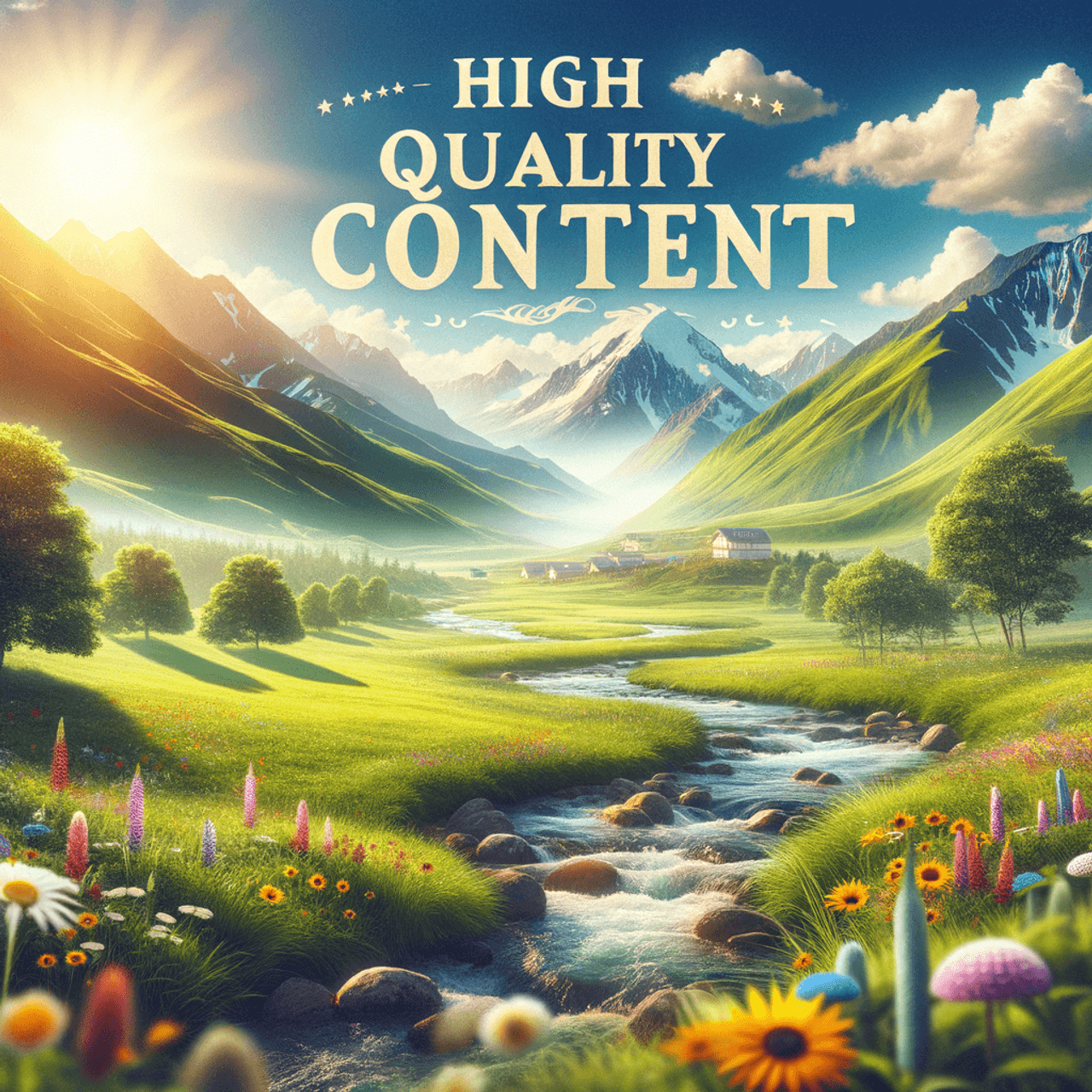by ContentERP | Oct 13, 2024 | Uncategorized
How to Publish High-Quality Content Without Missing Deadlines Using ContentERP
 They say, ‘The smallest patch can mend the biggest tear.’ In the world of content creation, this wisdom holds more weight than ever. As businesses rush to publish their next big article, blog post, or product description, the need to balance quality with timely delivery becomes a constant juggling act. But what if you didn’t have to choose between high-quality content and meeting your deadlines? What if both could exist in harmony?
They say, ‘The smallest patch can mend the biggest tear.’ In the world of content creation, this wisdom holds more weight than ever. As businesses rush to publish their next big article, blog post, or product description, the need to balance quality with timely delivery becomes a constant juggling act. But what if you didn’t have to choose between high-quality content and meeting your deadlines? What if both could exist in harmony?
Enter ContentERP, a powerful content management system designed to streamline your creative process, allowing you to consistently publish polished, compelling content while never missing a deadline. But how exactly does ContentERP transform this delicate balancing act into an effortless flow of productivity? Let’s explore the world of content creation with a tool that makes the impossible possible.
The High-Quality Content Conundrum
Content creation is both an art and a science. On one hand, you need to craft narratives that captivate your audience, build authority, and establish trust. On the other, you need to be strategic, data-driven, and efficient. This balancing act often leaves content creators asking themselves: how can we publish high-quality content without burning out or missing deadlines?
For many, the content process is a tangled mess of to-do lists, scattered drafts, and last-minute editing marathons. Writers are racing against time, squeezing creativity into tight schedules, and sacrificing quality for the sake of speed. But what if we told you that the right platform could organize your workflow, boost your efficiency, and help you deliver exceptional content consistently?
That’s where ContentERP comes in, offering a content management solution that turns the conundrum into a streamlined process.
1. The Power of a Centralized Workflow
One of the main reasons content deadlines are missed is the chaotic nature of most content processes. Ideas are scattered across emails, drafts sit untouched in cloud storage, and feedback is lost in a maze of messaging apps. This lack of organization creates bottlenecks that slow down production and, ultimately, compromise quality.
ContentERP eliminates this chaos by offering a centralized workflow. Imagine having all your ideas, drafts, feedback, and revisions in one place, easily accessible and clearly organized. With ContentERP, content creators can track progress at every stage—brainstorming, drafting, editing, publishing—without losing momentum. This seamless workflow ensures that your team stays on track, with deadlines in mind and quality intact.
Think of it as a well-orchestrated production line: each piece moves smoothly through the process, with no time wasted waiting for the next step. This not only keeps projects on time but also frees up mental bandwidth, allowing writers and editors to focus on the craft rather than the logistics.
2. Automate the Mundane, Focus on the Creative
In content creation, time is both friend and foe. While it takes time to craft a thoughtful, well-written blog post, much of that time is often eaten up by mundane tasks—scheduling, formatting, SEO optimization, and publishing. These repetitive, mechanical duties can slow you down and drain your creative energy.
Fortunately, ContentERP takes these tasks off your plate with its built-in automation features. From scheduling your content to optimizing SEO-friendly headlines, ContentERP handles the heavy lifting behind the scenes. This leaves you free to focus on what really matters: writing, editing, and refining high-quality content.
It’s as if you had a personal assistant who never misses a beat—keeping track of everything from deadlines to keyword placement. The result? You’re able to deliver content that not only ranks well but also resonates deeply with your audience, all without rushing through the process.
3. High-Quality Content at Scale
Creating high-quality content once is hard enough. Doing it consistently across multiple projects can feel like an impossible task. But here’s the truth: scaling content creation doesn’t mean sacrificing quality. It simply requires the right tools and processes in place.
With ContentERP, scaling your content efforts becomes manageable, even effortless. Its robust content planner allows you to oversee multiple projects at once, ensuring that each piece of content is meticulously planned, developed, and delivered. From the smallest blog post to the most intricate white paper, every project follows a structured path, allowing your team to hit deadlines without compromising on quality.
It’s like running a marathon with a GPS tracking every step, ensuring you stay on course without exhausting yourself before the finish line. ContentERP’s structured approach empowers content creators to maintain high standards, even as their workloads increase.
4. Built-In Collaboration for Flawless Execution
Content creation is rarely a solo act. From writers to editors to designers, each project involves multiple stakeholders working together to bring a piece of content to life. Yet, collaboration often becomes a stumbling block, with miscommunications, missed feedback, and duplicated efforts dragging down progress.
ContentERP transforms collaboration into a smooth, fluid process. With real-time editing, feedback loops, and clear task assignments, every team member knows exactly what’s needed, when it’s needed, and who’s responsible for each task. It’s like a relay race where each baton pass is flawless, ensuring that the final product is delivered on time and at the highest level of quality.
No more waiting for an email response or hunting for a misplaced document—ContentERP brings your team together in a unified workspace, making collaboration as easy as a conversation.
Conclusion: The Parable of the Two Farmers
 There’s an ancient parable about two farmers. One farmer spends his days rushing, trying to plant as many seeds as possible before the rains come. His fields are large, but his work is hasty, and many of the seeds are scattered unevenly. The other farmer, however, takes his time, ensuring each seed is planted with care. His fields are smaller, but when the harvest comes, his crops are plentiful and strong.
There’s an ancient parable about two farmers. One farmer spends his days rushing, trying to plant as many seeds as possible before the rains come. His fields are large, but his work is hasty, and many of the seeds are scattered unevenly. The other farmer, however, takes his time, ensuring each seed is planted with care. His fields are smaller, but when the harvest comes, his crops are plentiful and strong.
In the world of content creation, many of us fall into the trap of the first farmer—rushing to meet deadlines, spreading our efforts thin, and compromising quality. But with tools like ContentERP, you can be like the second farmer, producing thoughtful, well-crafted content without the panic of missed deadlines.
Imagine a world where your content process feels like a well-oiled machine—where your creative ideas flow freely, your deadlines are always met, and your content consistently shines. With ContentERP, that world is within reach.
So, are you ready to cultivate high-quality content and meet every deadline with confidence? Sign up for ContentERP today and discover how seamlessly you can turn your content creation process into a productive, stress-free journey. After all, the best crops are the ones that are planted with care, nurtured with consistency, and harvested at just the right time.
by ContentERP | Oct 13, 2024 | Uncategorized
5 Best Practices for Using ContentERP’s Keyword Research Tools
There’s an old proverb that says, “He who fails to plan, plans to fail.” Nowhere is this more relevant than in the digital marketing world, particularly when it comes to SEO. In the age of information overload, keyword research has become the backbone of every successful content strategy. Without it, even the most well-crafted articles risk being buried beneath the sheer mass of digital content. But with the right tools, you can unlock the doors to visibility and relevance.
 Enter ContentERP’s keyword research tools—the digital equivalent of a master map, guiding you through the labyrinth of search engine optimization. But just having the tools isn’t enough; knowing how to use them effectively is the key. In this article, we’ll explore the five best practices for making the most out of ContentERP’s keyword planner and keyword search features to drive traffic, boost engagement, and get your content in front of the right audience.
Enter ContentERP’s keyword research tools—the digital equivalent of a master map, guiding you through the labyrinth of search engine optimization. But just having the tools isn’t enough; knowing how to use them effectively is the key. In this article, we’ll explore the five best practices for making the most out of ContentERP’s keyword planner and keyword search features to drive traffic, boost engagement, and get your content in front of the right audience.
1. Cast a Wide Net, Then Narrow It Down
When beginning your keyword search, it’s tempting to immediately target the most popular, high-traffic keywords. However, this is often like fishing in a sea where everyone else is casting their lines—it’s crowded, and your chances of success are slim. Instead, it’s wise to start by casting a wide net. ContentERP’s keyword planner can generate a broad range of potential keywords, giving you a full view of the possibilities available.
Once you have this wide range, begin narrowing it down by focusing on long-tail keywords. These are phrases that may have lower search volume but are highly specific and often less competitive. For example, instead of targeting “keyword research tool,” you might target “best keyword research tool for small businesses.” With ContentERP, you can easily compare the competitiveness and relevance of different keywords, helping you zero in on the ones that will give you the most bang for your buck.
2. Keep User Intent at the Core of Your Strategy
Imagine you’re a detective, and each keyword is a clue. The real puzzle, however, is understanding what the searcher is trying to solve. This is where user intent comes into play. It’s not just about what people are searching for, but why they’re searching for it. Are they looking for information, seeking to make a purchase, or trying to navigate to a particular site?
ContentERP’s keyword research tools allow you to analyze user intent behind each keyword, helping you create content that doesn’t just attract visitors, but answers their needs. For instance, if you find that a high-ranking keyword like “best budget smartphones” typically signals purchase intent, you can craft content designed to convert readers into buyers. This way, your content becomes the solution to their query, rather than just another stop along the way.
3. Don’t Underestimate the Power of LSI Keywords
In SEO, LSI (Latent Semantic Indexing) keywords are like the unsung heroes of content optimization. While primary keywords are the stars of the show, LSI keywords play a crucial supporting role, helping search engines understand the context and relevance of your content. Think of them as the background harmonies in a song—they may not be front and center, but they add depth and resonance.
ContentERP’s keyword planner helps you identify LSI keywords that are related to your primary keywords. These might be synonyms, related concepts, or frequently associated phrases. Including these in your content not only enhances SEO but also enriches the reading experience, making your content more natural and less robotic.
For example, if your main keyword is “best SEO tools,” related LSI keywords might include “keyword analysis software” or “on-page optimization tools.” By incorporating these seamlessly into your content, you boost your chances of ranking for multiple terms and create a more engaging narrative for your audience.
4. Monitor Trends to Stay Ahead of the Curve
The digital landscape is constantly shifting, and what’s trending today might not be relevant tomorrow. This is why it’s essential to keep your finger on the pulse of industry trends. With ContentERP’s keyword search feature, you can track keyword performance over time, identifying trends before they hit the mainstream.
For example, you might discover that a keyword like “AI writing tools” is gradually gaining traction, allowing you to craft content that capitalizes on the growing interest. By staying ahead of the curve, you position yourself as a thought leader in your industry, attracting an audience before the market becomes oversaturated.
Additionally, ContentERP provides insights into seasonal fluctuations, helping you tailor your content to align with high-traffic periods. This is especially useful for businesses that rely on seasonal marketing, such as retail or travel industries. Timing, after all, is everything.
5. Consistently Evaluate and Refine Your Strategy
SEO isn’t a set-it-and-forget-it strategy. Much like tending to a garden, it requires consistent care, attention, and refinement. What works one month may not work the next, and search engines are always evolving. To stay on top, you need to regularly evaluate your keyword performance and adjust your approach accordingly.
With ContentERP’s advanced analytics, you can monitor which keywords are driving traffic, which ones are underperforming, and where there’s room for improvement. This allows you to refine your content strategy on an ongoing basis, ensuring that you’re always targeting the most relevant and profitable keywords. It’s like tuning a fine instrument—the more precisely you adjust, the better the harmony between your content and your audience.
Conclusion: The Right Tools for the Job
 Using a keyword research tool is like having a map in a vast, digital wilderness. It guides your content creation, ensuring you’re always heading in the right direction. But, as the saying goes, “A fool with a tool is still a fool.” It’s not just about having the tools—it’s about knowing how to use them effectively. That’s where ContentERP excels, empowering you to harness the full potential of keyword research in a way that’s intuitive, actionable, and results-driven.
Using a keyword research tool is like having a map in a vast, digital wilderness. It guides your content creation, ensuring you’re always heading in the right direction. But, as the saying goes, “A fool with a tool is still a fool.” It’s not just about having the tools—it’s about knowing how to use them effectively. That’s where ContentERP excels, empowering you to harness the full potential of keyword research in a way that’s intuitive, actionable, and results-driven.
As Henry Ford once said, “Before everything else, getting ready is the secret of success.” With ContentERP, you’re not just getting ready—you’re setting yourself up for success, armed with the insights and tools necessary to dominate the digital landscape.
So, are you ready to take your keyword research to the next level? Don’t just guess what your audience wants—know it with ContentERP’s keyword planner. Sign up today and discover how easily you can craft content that not only engages but also ranks where it matters. The path to SEO success is clear, and ContentERP is here to guide you every step of the way.
by ContentERP | Oct 13, 2024 | Uncategorized
How to Use ContentERP for Real-Time Collaboration
In a high-stakes corporate jungle, where every second is precious and missteps are costly, agility is the key to survival. Meet Team Phoenix, a group of marketing professionals tasked with launching a campaign in less than 48 hours. The clock is ticking, tensions are high, and traditional communication tools are crumbling under the pressure. Then, like a beacon in the storm, they discover ContentERP—a platform promising seamless, real-time collaboration. Can it save the day?

The Tale of Team Phoenix: A Prelude to Real-Time Collaboration
It was 9 p.m. on a Thursday when Team Phoenix received the unexpected call. Their CEO, notorious for sudden pivots, demanded a full-blown marketing strategy for a new product launch—by Saturday. This wasn’t just a curveball; it was a sinker pitch aimed at their sanity.

For a moment, panic ensued. How could they pull this off? Google Forms was useful for gathering data, and Microsoft Teams Meeting could coordinate discussions, but the team needed something more—an integrated solution that would allow them to brainstorm, strategize, and execute in real-time without any hitches. Enter ContentERP, the digital Swiss Army knife they didn’t know they needed.
ContentERP: A Brief Overview
ContentERP is like a well-conducted orchestra, seamlessly synchronizing the chaotic symphony of collaborative work. It combines project management, content creation, and real-time communication into one platform. Unlike traditional tools that often function as isolated silos, ContentERP acts as a cohesive force, connecting every cog in the machine. It’s not just another tool; it’s a game-changer.
Setting Up the Stage: How to Start with ContentERP
Getting started with ContentERP is as straightforward as stepping onto a moving escalator. The platform integrates effortlessly with existing tools like Google Forms, Microsoft Teams Meeting, and various collaborative whiteboards, making the transition smooth and intuitive.

-
Create a Project Workspace: Think of it as your war room—a centralized hub where your team can see every detail of the project at a glance. You can set deadlines, assign tasks, and share documents, all in one place.
-
Integrate Your Tools: ContentERP’s compatibility with external tools is akin to adding turbo fuel to your workflow. You can integrate Google Forms to collect data directly into your workspace, or synchronize it with Microsoft Teams Meeting for seamless video conferences. Imagine having your collaborative whiteboard, brainstorming sessions, and data analytics all in one view!
-
Real-Time Collaboration: This is where the magic happens. Whether it’s editing a document, commenting on a proposal, or tracking task progress, ContentERP updates everyone in real time. It’s like having a digital roundtable where ideas bounce around at the speed of thought.
The Phoenix Rises: Leveraging ContentERP for Dynamic Teamwork
As Team Phoenix dived into their 48-hour challenge, they quickly realized the power of ContentERP. Gone were the days of endless email threads, conflicting document versions, and missed messages. ContentERP provided a virtual meeting room, a content management system, and a project tracker all rolled into one.
-
Breaking Down Silos with Integrated Communication
Imagine trying to row a boat with everyone paddling in different directions. That’s what it feels like when teams use disconnected tools for communication and project management. ContentERP eradicates these silos. By integrating with Microsoft Teams Meeting, it allows for seamless video and chat interactions. The team used this feature to hold quick meetings to brainstorm ideas, review feedback, and make instant decisions.
-
Dynamic Content Creation and Feedback Loop
ContentERP’s real-time editing and commenting features transformed how Team Phoenix created content. With a collaborative whiteboard feature, brainstorming sessions turned into creative storm surges. Ideas flowed freely, comments were immediate, and changes were reflected instantaneously.
The platform became a living, breathing entity, pulsating with the team’s collective creativity and energy.
-
Data-Driven Decision Making with Google Forms Integration
The team needed rapid feedback from customers to fine-tune their strategy. Using Google Forms integrated within ContentERP, they created surveys and collected responses in record time. The data streamed into their dashboard, allowing for quick analysis and agile strategy adjustments.
It was as if ContentERP itself was whispering insights into their ears, guiding their decisions with real-time data.
-
Tracking Progress and Staying Aligned
With the clock ticking, there was no room for missteps. ContentERP’s project management tools allowed the team to track progress, spot bottlenecks, and stay aligned with the overall strategy. Task assignments and updates were visible to all, reducing confusion and ensuring accountability.
The Aftermath: A Triumph Against the Odds
By Saturday morning, Team Phoenix had not only completed the campaign but also exceeded expectations. Their CEO was astounded by the quality and cohesion of their work, considering the tight deadline. It wasn’t just a victory; it was a testament to the power of real-time collaboration facilitated by ContentERP.
This tale of triumph, however, is not an isolated incident. In today’s fast-paced world, where projects evolve as quickly as the news cycle, businesses need tools that enable agility and teamwork. ContentERP is not just a platform; it’s a new way of working—fluid, connected, and efficient.
Mastering ContentERP: Best Practices for Effective Collaboration
-
Centralize Your Resources: Use the project workspace to store all relevant documents, meeting notes, and content drafts. This centralization prevents the ‘lost in email’ syndrome and ensures everyone has access to the latest information.
-
Leverage Real-Time Edits and Comments: Avoid the back-and-forth of email edits. Use real-time document collaboration to make changes and provide feedback instantly.
-
Integrate External Tools Smartly: Connect Google Forms for surveys, Microsoft Teams Meeting for video calls, and collaborative whiteboards for brainstorming to create a seamless workflow that keeps the entire team on the same page.
-
Track Progress with Precision: Use ContentERP’s project management features to monitor task completion, track deadlines, and identify potential delays before they become issues.
The Future of Collaboration
As we stand on the precipice of a new era in digital collaboration, it’s clear that the tools we use are as critical as the strategies we employ. ContentERP is not just a tool—it’s a catalyst for change, transforming how teams work together in real-time. It’s a reminder that in the digital age, collaboration is not just about connecting people; it’s about aligning their efforts, creativity, and vision towards a common goal.
To quote the great industrialist Henry Ford, “Coming together is a beginning, staying together is progress, and working together is success.” ContentERP embodies this ethos, making it possible for teams to not only come together but to thrive together in the modern workplace.
Team Phoenix may have faced a daunting challenge, but with the right tools at their disposal, they soared. And so can any team willing to embrace the future of real-time collaboration with ContentERP.
by ContentERP | Oct 13, 2024 | Uncategorized
How to Stay Productive on the Go with Mobile Content Tools
In 1931, Mahatma Gandhi stood before a crowd in London’s Kingsley Hall and delivered a speech that resonated across continents. “I want world sympathy in this battle of right against might,” he said, imploring listeners to embrace change through peaceful resistance. Gandhi’s words were not just about political freedom—they were a call to action for resilience, adaptability, and the power of the human spirit to transcend barriers. Today, as we navigate an ever-evolving digital landscape, Gandhi’s message still resonates. The barriers we face may not be colonial empires, but the relentless demands on our time and attention. Yet, like Gandhi, we too can harness tools and strategies to overcome these obstacles.
In an era where remote work and constant connectivity are the norms, staying productive while on the move is a skill of paramount importance. Whether you’re a digital nomad hopping between cafes, a social media manager juggling multiple accounts, or a CEO en route to the next big pitch, maintaining efficiency can feel like a juggling act. But with the right mobile content tools, the impossible becomes manageable. Just as Gandhi transformed salt into a symbol of resistance, you can turn your mobile device into a powerhouse of productivity.

The Backbone: Mobile Content Management with ContentERP
Imagine being able to manage your entire content strategy from the palm of your hand. ContentERP, a robust mobile content management system, is designed to do just that. It’s like having a personal assistant, project manager, and creative collaborator rolled into one sleek interface. With ContentERP, you can draft, edit, and publish content, track performance metrics, and even collaborate with your team—all without needing to sit at a desk.
ContentERP allows you to plan your editorial calendar, assign tasks, and monitor deadlines on the go. This is particularly useful for team leaders who need to keep their finger on the pulse of multiple projects simultaneously. It’s the equivalent of Gandhi’s salt march, but instead of defying an empire, you’re defying inefficiency. Every swipe, tap, and notification brings you one step closer to achieving your goals.
Hootsuite: The Maestro of Social Media Scheduling
In the digital world, time is as elusive as a puff of smoke. One moment you’re on top of your content game, and the next, your perfectly timed social media posts are slipping through the cracks. Enter Hootsuite—a social media scheduling tool that acts like a maestro conducting an orchestra. It coordinates your posts across multiple platforms, ensuring that each message hits the right note at the right time.
With Hootsuite’s mobile app, you can schedule, review, and edit posts while sipping coffee in a Parisian bistro or waiting for a train in Tokyo. Its interface is as intuitive as a well-worn passport, making it easy to toggle between accounts, monitor engagement, and respond to followers—all from your phone. Think of it as a virtual time machine, allowing you to orchestrate a day’s worth of social media activity in a few minutes.
Social Media Scheduling Tools: Your Digital Swiss Army Knife
Social media scheduling tools like Buffer, Later, and Sprout Social are indispensable for anyone looking to maintain a strong digital presence without being tethered to a desk. They’re the Swiss Army knives of mobile content management, equipped with everything from post-scheduling to analytics tracking.
Imagine you’re stuck in an airport lounge with a few hours to kill. Instead of mindlessly scrolling through your feed, you can use these tools to plan your content for the next week, review analytics, and even engage with your audience. Each tool offers unique features, like Buffer’s easy-to-use queue system or Later’s visually driven planning grid. These tools transform idle moments into productive ones, proving that, just as a painter sees a blank canvas, a savvy content creator sees opportunity in every delay.
Content Creation on the Fly: Mobile Editing and Design Apps
Creating compelling content on the go isn’t just about managing schedules—it’s about having the ability to craft and refine your message whenever inspiration strikes. Mobile apps like Adobe Spark, Canva, and Grammarly are perfect companions for this purpose. They’re like portable art studios and editorial desks, enabling you to design eye-catching visuals, refine your grammar, and polish your prose with just a few taps.
Say you’re hiking in the Andes and a breathtaking vista sparks an idea for your next blog post. With Adobe Spark, you can create a stunning visual post on the spot, while Grammarly ensures your caption is as crisp as the mountain air. It’s a creative freedom that would make even Hemingway envious.
Collaborative Tools: Keeping the Team in Sync
Gandhi once said, “The best way to find yourself is to lose yourself in the service of others.” Collaboration is the lifeblood of any successful venture, and mobile tools like Slack, Microsoft Teams, and Trello make it easier than ever to stay connected and productive, no matter where you are.
ContentERP integrates seamlessly with these platforms, allowing you to discuss projects, share updates, and coordinate tasks without missing a beat. It’s as if your entire team is with you, brainstorming ideas in a virtual conference room, even if they’re spread across different time zones. Each message, file, and update flows as smoothly as a well-executed relay race, with everyone playing their part.

Strategies for Staying Productive on the Move
While tools like ContentERP and Hootsuite are powerful, they’re only as effective as the strategies you use them with. Here are a few tips to make the most of your mobile productivity arsenal:
1. Set Clear Boundaries
Just because you can work anywhere doesn’t mean you should work everywhere. Establish specific times and places where you’ll focus on tasks, and stick to them. It’s like setting up a virtual office that travels with you.
2. Batch Tasks
Group similar tasks together to maximize efficiency. Use your commute for social media engagement, dedicate time at the airport for content planning, and reserve quiet evenings for writing and editing. This approach keeps your mind focused and your workload manageable.
3. Leverage Notifications Wisely
Notifications are a double-edged sword. They can keep you on track, or they can derail your focus. Use them sparingly, setting up alerts only for the most critical updates. This way, you’re not at the mercy of every ping and buzz.
Your Mobile Productivity, Reimagined
As Gandhi’s words continue to inspire change across generations, so too can you transform your productivity, one mobile tool at a time. With the right strategies and a suite of powerful apps like ContentERP, you can turn any location into your personal productivity hub.
So, what will you create on the go today? Will you let the demands of a mobile lifestyle hinder your potential, or will you seize the tools at your disposal to craft a masterpiece of efficiency and creativity? The choice, like the journey, is yours to make.
by ContentERP | Oct 13, 2024 | Uncategorized
How to Use ContentERP to Boost Team Efficiency

In the early 20th century, the world marveled as the Panama Canal took shape—a feat of engineering that would alter global trade routes forever. But beyond its innovative design and sheer scale, what made the canal’s construction remarkable was the way a diverse team, against all odds, learned to work together with unprecedented efficiency. Engineers, laborers, and visionaries from all corners of the globe united, surmounting daunting challenges like disease, logistical nightmares, and treacherous terrain. They didn’t just build a canal; they built a testament to the power of effective teamwork.
Today, the business landscape is a far cry from the jungles of Panama, yet the principles of team efficiency remain the same. In a world where digital communication often replaces face-to-face interaction, achieving a cohesive, efficient team can feel like navigating an impossible labyrinth. Enter ContentERP, a revolutionary tool designed to streamline content management and boost team efficiency. Much like the mechanisms of the Panama Canal, ContentERP aligns disparate elements, ensuring a smooth, steady flow of ideas and execution.
But how exactly does ContentERP turn a fragmented team into a well-oiled machine? Let’s explore how this platform can transform your team’s productivity, collaboration, and overall effectiveness.
The Foundation: What is Team Effectiveness?
Before diving into how ContentERP can elevate your team, it’s essential to understand what team effectiveness truly means. At its core, team effectiveness is the ability of a group to achieve its goals in a timely and efficient manner. This involves not only completing tasks but also fostering a collaborative environment where communication is seamless, resources are well-managed, and individual contributions are valued.
Team effectiveness isn’t just about checking boxes on a to-do list. It’s like a jazz ensemble, where each member’s skill and creativity harmonize to produce something greater than the sum of its parts. It’s about creating an environment where everyone is in sync, leveraging their strengths, and contributing to a shared purpose.
Setting the Stage: The Importance of Clear Communication
Imagine trying to build the Panama Canal without a clear blueprint or a shared understanding among the team. Chaos would reign supreme. Similarly, in any content strategy, clarity of communication is paramount. One of the primary features of ContentERP is its ability to centralize all communication, making it the perfect hub for discussing strategies, assigning tasks, and tracking progress.
ContentERP offers a shared workspace where teams can collaborate in real-time. No more endless email chains or lost messages buried in chat apps. It’s like a virtual conference room where everyone has a seat at the table, and every voice is heard. By keeping all communication in one place, teams can reduce misunderstandings, streamline decision-making, and keep projects moving forward with the precision of a Swiss watch.
Building the Canal: Organizing Workflow with ContentERP
A cluttered workflow is like a ship navigating a canal filled with obstacles—progress is slow, and collisions are inevitable. ContentERP eliminates these bottlenecks by providing a clear and structured approach to content planning and execution.

1. Content Calendar: The Master Blueprint
Just as the engineers of the Panama Canal relied on detailed plans, a content team needs a robust content calendar to guide its efforts. With ContentERP’s content calendar, teams can visualize their entire content strategy at a glance. This tool allows for scheduling, assigning tasks, and setting deadlines, ensuring everyone knows what’s happening and when.
The calendar also integrates with other team tools, enabling seamless updates and eliminating the need for manual input. It’s not just a calendar; it’s a strategic command center that keeps everyone aligned and on track.
2. Task Management: Assign and Conquer
In large-scale projects, roles must be clearly defined, and responsibilities allocated efficiently. ContentERP’s task management features are like having a project foreman who knows exactly who should be doing what at any given time. Assign tasks, set priorities, and monitor progress—all within the platform.
Tasks are not just assigned; they’re tracked. Team members can update their progress, flag obstacles, and seek assistance directly through the system. This level of visibility ensures that no task falls through the cracks and that every team member knows their role and how it contributes to the bigger picture.
3. Content Approval Workflows: Quality Assurance Made Easy
Effective teams don’t just produce a high quantity of work; they ensure high quality as well. ContentERP’s approval workflows act as quality checkpoints, ensuring that all content meets the team’s standards before it goes live. It’s like the canal’s lock system, meticulously managing the flow to prevent errors and maintain quality control.
With clearly defined review stages, feedback loops, and approval requests, teams can refine their content with precision and avoid the last-minute scrambles that often accompany poorly managed projects.
Successful Collaboration Examples: Learning from the Best
Throughout history, some of the most remarkable achievements have been the result of effective collaboration. From the moon landing to the creation of the first Apple computer, these successes were built on the foundations of teamwork, shared vision, and clear communication.
In today’s corporate world, companies like Google and Pixar exemplify what successful collaboration looks like. Google’s “Project Aristotle” discovered that psychological safety—where team members feel safe to take risks and express themselves—is crucial for team success. Pixar, on the other hand, uses a concept called “Braintrust,” where candid feedback and open dialogue are encouraged during the development of their animated films.
ContentERP fosters a similar environment of open communication and shared responsibility, making it an invaluable tool for teams aiming to achieve high levels of collaboration and innovation.

Innovative Team Improvement Ideas: Beyond the Basics
Implementing ContentERP can do wonders for streamlining workflows and enhancing collaboration, but maximizing its potential requires creative thinking and continuous improvement. Here are a few innovative ideas to take your team’s efficiency to the next level:
1. Gamify the Process
Turn content creation into a game by setting up challenges and rewards. For instance, you can create a leaderboard for meeting deadlines or achieving certain engagement metrics. This not only makes the process more engaging but also encourages healthy competition and team spirit.
2. Integrate AI for Content Insights
Leverage AI-powered tools integrated with ContentERP to analyze content performance and audience behavior. This data can help refine your strategy, making your team’s efforts more targeted and effective. It’s like having a digital oracle guiding your content journey.
3. Host “Content Jams”
Take a page from the music industry and host “content jam sessions,” where team members brainstorm and create content together in a focused, energetic environment. This can help break the monotony of solo work and lead to fresh, innovative ideas.
The Path to Success
As the Panama Canal transformed global trade, so too can ContentERP transform your team’s efficiency. By centralizing communication, organizing workflows, and fostering collaboration, this tool can help your team navigate the complexities of content creation with ease and precision.
In the words of Henry Ford, “Coming together is a beginning, staying together is progress, and working together is success.” The question now is, how will you leverage these tools to build your own path to success? The journey to greater efficiency and collaboration starts here.
by ContentERP | Oct 13, 2024 | Uncategorized
The Best Tools for Managing Your Content Calendar
In the late 19th century, the world’s first modern office building was constructed in Chicago: the Home Insurance Building. Rising to ten stories, it was a marvel of engineering, using steel-frame construction to support its weight. This breakthrough not only redefined the skyline but also revolutionized how businesses operated. Suddenly, vertical space became valuable, allowing companies to efficiently organize their workflows. Much like the steel skeletons of skyscrapers, a well-managed content calendar provides the structural support necessary to elevate your brand’s visibility, turning what could be chaos into a symphony of productivity.
Managing a content calendar might not be as dramatic as building skyscrapers, but the underlying principle remains the same: structure fosters success. With the rise of digital platforms and the constant churn of social media, it’s easy to feel overwhelmed by the sheer volume of content to be created, scheduled, and published. But don’t worry—some tools can help you stay organized and on top of your game. Here, we’ll explore the best tools for managing your content calendar and how they can help you build your brand’s digital skyscraper, one post at a time.

ContentERP: Your Command Center
Imagine if the Home Insurance Building foreman had access to a dashboard that tracked every beam, brick, and bolt in real-time. That’s what ContentERP offers for your content calendar. It’s an all-in-one platform that not only helps you plan your content but also tracks the performance of each piece, ensuring every effort counts.
With ContentERP, you can create a content calendar template tailored to your brand’s needs, categorize content types, assign tasks to team members, and even set deadlines with automatic reminders. It’s like having a personal assistant who never forgets a meeting and always knows what’s next on the agenda. Plus, its analytics capabilities allow you to measure the impact of your content strategy, helping you refine your approach and scale your efforts.
Google Calendar: The Classic Choice
Just as Chicago’s first skyscraper stood the test of time, Google Calendar remains a steadfast tool in any content manager’s arsenal. Its simple, user-friendly interface is perfect for those who prefer a no-fuss approach. While it may lack some of the advanced features of specialized tools, it’s excellent for visualizing your content schedule at a glance.
Using Google Calendar, you can set up color-coded categories for different content types, such as blog posts, social media updates, and email campaigns. You can even integrate it with other free social media management tools to streamline your workflow. It’s the digital equivalent of a classic leather-bound planner: reliable, straightforward, and always within reach.
Free Social Media Management Tools: The Unsung Heroes
In the world of content management, free social media management tools are like the unsung heroes of a great symphony—often overlooked, yet essential to the performance. Platforms like Buffer, Hootsuite, and Zoho Social allow you to schedule posts, track engagement, and even manage multiple accounts without spending a dime.
These tools are particularly useful for small businesses or solopreneurs who need to make every dollar stretch. With features like post scheduling and analytics, you can ensure that your content goes live at optimal times, even if you’re not at your desk. It’s like setting your social media posts on autopilot, allowing you to focus on creating compelling content rather than worrying about when to hit ‘publish.’
Notion Calendar: The Versatile Multitasker
If Google Calendar is the leather-bound planner, Notion Calendar is the Swiss Army knife of content management. Notion is not just a calendar tool; it’s a robust workspace where you can manage projects, take notes, and collaborate with your team—all in one place.
The Notion calendar view allows you to visualize your content schedule while linking each entry to detailed notes, files, and to-do lists. This makes it an ideal tool for teams juggling multiple projects or those who prefer a more holistic approach to content planning. It’s as if you’ve condensed a skyscraper’s entire infrastructure—electricity, plumbing, HVAC—into one seamless system. Everything you need is just a click away.
Creating a Content Calendar Template

Building a solid content calendar is like drawing up blueprints for a building. You need to know what goes where and when to ensure a smooth execution. A content calendar template can serve as your blueprint, helping you map out your content in advance.
Start by listing all the types of content you plan to create, such as blog posts, social media updates, and newsletters. Then, decide on a frequency for each—weekly, bi-weekly, or monthly. Populate your calendar with these content types, assigning deadlines and responsible team members for each. Using tools like ContentERP or Notion, you can easily create a dynamic content calendar template that updates in real-time, reflecting any changes in your strategy.
Choosing the Right Tool for You
Selecting the right tool for managing your content calendar depends on your specific needs and resources. If you’re looking for an all-encompassing solution with robust analytics, ContentERP is a solid choice. If you prefer something simple and familiar, Google Calendar is your go-to. For those who want versatility and collaboration features, Notion Calendar is unbeatable. And let’s not forget the free social media management tools—perfect for those just starting out or operating on a tight budget.
Building Your Content Skyscraper
Much like the architects and engineers who dared to build upward, managing your content calendar is about reaching new heights. Each post, tweet, and video is a building block in your digital skyscraper, and choosing the right tools is crucial to keeping your structure solid and your vision intact.
So, which tools will you choose to support your brand’s growth? Will you build a streamlined, efficient system that allows you to soar above the competition? Or will you remain grounded, struggling to keep up with the relentless pace of the digital world? The decision is yours, and the sky’s the limit.
They say, ‘The smallest patch can mend the biggest tear.’ In the world of content creation, this wisdom holds more weight than ever. As businesses rush to publish their next big article, blog post, or product description, the need to balance quality with timely delivery becomes a constant juggling act. But what if you didn’t have to choose between high-quality content and meeting your deadlines? What if both could exist in harmony?
There’s an ancient parable about two farmers. One farmer spends his days rushing, trying to plant as many seeds as possible before the rains come. His fields are large, but his work is hasty, and many of the seeds are scattered unevenly. The other farmer, however, takes his time, ensuring each seed is planted with care. His fields are smaller, but when the harvest comes, his crops are plentiful and strong.
